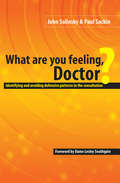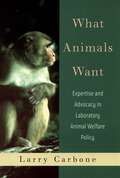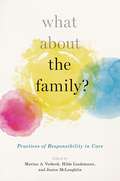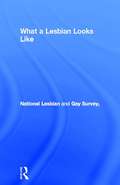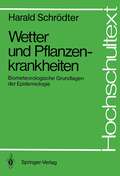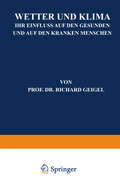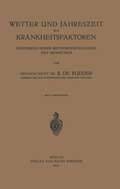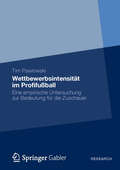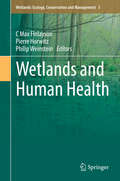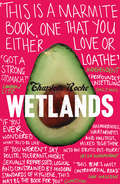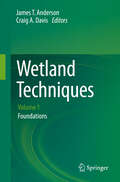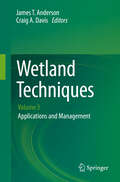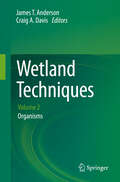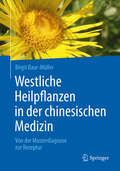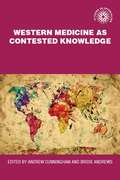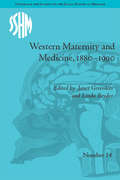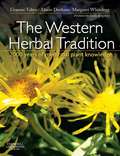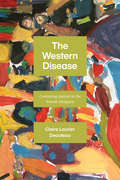- Table View
- List View
What are You Feeling Doctor?: Identifying and Avoiding Defensive Patterns in the Consultation
by John Salinsky Paul SackinGuidelines are powerful instruments of assistance to clinicians capable of extending the clinical roles of nurses and pharmacists. Purchasers and managers perceive them as technological tools guaranteeing treatment quality. Guidelines also offer mechanisms by which doctors and other health care professionals can be made more accountable to their patients. But how can clinicians tell whether a guideline has authority and whether or not it should be followed? Does the law protect doctors who comply with guidelines? Are guideline developers liable for faulty advice? This timely book provides a comprehensive and accessible analysis of the many medical and legal issues arising from the current explosion of clinical guidelines. Featuring clear summaries of relevant UK US and Commonwealth case law it is vital reading for all doctors health care workers managers purchasers patients and lawyers.
What Animals Want: Expertise and Advocacy in Laboratory Animal Welfare Policy
by Larry CarboneLarry Carbone, a veterinarian who is in charge of the lab animal welfare assurance program at a major research university, presents this scholarly history of animal rights. Biomedical researchers, and the less fanatical among the animal rights activists will find this book reasonable, humane, and novel in its perspective. It brings a novel, sociological perspective to an area that has been addressed largely from a philosophical perspective, or from the entrenched positions of highly committed advocates of a particular position in the debate.
What Animals Want: Expertise and Advocacy in Laboratory Animal Welfare Policy
by Larry CarboneLarry Carbone, a veterinarian who is in charge of the lab animal welfare assurance program at a major research university, presents this scholarly history of animal rights. Biomedical researchers, and the less fanatical among the animal rights activists will find this book reasonable, humane, and novel in its perspective. It brings a novel, sociological perspective to an area that has been addressed largely from a philosophical perspective, or from the entrenched positions of highly committed advocates of a particular position in the debate.
What About the Family?: Practices of Responsibility in Care
by Hilde Lindemann and Janice McLaughlinHealth and social care decisions, and how they impact a family, are often viewed from the perspective of the individual family member making them--for example, the role of the parent in surrogacy questions, the care of the elderly, or decisionis that involve fetuses or organ donations. This volume represents a concerted, collaborative effort to depart from this practice--it shows, rather, that the family unit as a whole shapes and influences the patient's decisions and very understanding of the choice at hand. The family is intrinsic and inseparable from such ethical choices. This deeper level of thinking about families and health care poses an entirely new set of difficult questions. Which family members are relevant in influencing a patient, and why is this so? What is a family, in the first place? What duties does a family have to its own members? This volume, edited by bioethicists Hilde Lindemann, Marian Verkerk, and Janice McLaughlin, develops an ethic radically distinct from health care ethics, feminist ethics, or an ethic of care, even though authors draw on many of the resources those approaches offer. What makes an ethics of families distinctive is that it theorizes relationships characterized by ongoing intimacy and partiality among people who are not interchangeable, and remains centered on the practices of responsibility arising from these relationships. What About the Family? represents an interdisciplinary effort, drawing, among other resources, on its authors' backgrounds in sociology, nursing, philosophy, bioethics, and the medical sciences. Contributors begin from the assumption that any ethical examination of the significance of family ties to health and social care will benefit from a dialogue with the debates about family occuring in these other disciplinary areas, and examine why families matter, how families are recognized, how families negotiate responsibilities, how families can participate in treatment decision making, and how justice operates in families.
What About the Family?: Practices of Responsibility in Care
Health and social care decisions, and how they impact a family, are often viewed from the perspective of the individual family member making them--for example, the role of the parent in surrogacy questions, the care of the elderly, or decisionis that involve fetuses or organ donations. This volume represents a concerted, collaborative effort to depart from this practice--it shows, rather, that the family unit as a whole shapes and influences the patient's decisions and very understanding of the choice at hand. The family is intrinsic and inseparable from such ethical choices. This deeper level of thinking about families and health care poses an entirely new set of difficult questions. Which family members are relevant in influencing a patient, and why is this so? What is a family, in the first place? What duties does a family have to its own members? This volume, edited by bioethicists Hilde Lindemann, Marian Verkerk, and Janice McLaughlin, develops an ethic radically distinct from health care ethics, feminist ethics, or an ethic of care, even though authors draw on many of the resources those approaches offer. What makes an ethics of families distinctive is that it theorizes relationships characterized by ongoing intimacy and partiality among people who are not interchangeable, and remains centered on the practices of responsibility arising from these relationships. What About the Family? represents an interdisciplinary effort, drawing, among other resources, on its authors' backgrounds in sociology, nursing, philosophy, bioethics, and the medical sciences. Contributors begin from the assumption that any ethical examination of the significance of family ties to health and social care will benefit from a dialogue with the debates about family occuring in these other disciplinary areas, and examine why families matter, how families are recognized, how families negotiate responsibilities, how families can participate in treatment decision making, and how justice operates in families.
What a Lesbian Looks Like
by National Lesbian and Gay SurveyThe National Lesbian and Gay Survey is a mass observation project set up in 1985 to record the experience of lesbians and gay men. Since that time, lesbian and gay volunteers have provided accounts on a wide range of issues pertinent to lesbian and gay life. "What a Lesbian Looks Like" draws on this material to provide an anthology of personal writings from lesbians nationwide. The volunteers come from all walks of life, from the unemployed to holders of high powered jobs, and represent all age groups. A ll aspects of lesbian experience are covered, including first sexual encounters, long term relationships, the difficulties of "coming out" and Clause 28. This book should be of interest to undergraduates, postgraduates and academics in the fields of women's studies, gender studies and cultural studies.
What a Lesbian Looks Like
by National Lesbian and Gay SurveyThe National Lesbian and Gay Survey is a mass observation project set up in 1985 to record the experience of lesbians and gay men. Since that time, lesbian and gay volunteers have provided accounts on a wide range of issues pertinent to lesbian and gay life. "What a Lesbian Looks Like" draws on this material to provide an anthology of personal writings from lesbians nationwide. The volunteers come from all walks of life, from the unemployed to holders of high powered jobs, and represent all age groups. A ll aspects of lesbian experience are covered, including first sexual encounters, long term relationships, the difficulties of "coming out" and Clause 28. This book should be of interest to undergraduates, postgraduates and academics in the fields of women's studies, gender studies and cultural studies.
Wetter und Pflanzenkrankheiten: Biometeorologische Grundlagen der Epidemiologie (Hochschultext)
by Harald SchrödterEin gezielter Einsatz von Pflanzenschutzmitteln ist für die Sicherung der Nahrungsgrundlage der Bevölkerung unbedingt notwendig. Dazu ist eine vertiefte Kenntnis der Dynamik der Entwicklung von Pflanzenkrankheiten, insbesondere die Wirkung von atmosphärischen Umweltbelastungen auf Pflanzen, eine wesentliche Voraussetzung. Ausgehend von allgemeinen Aspekten der Beziehung zwischen Pflanzenkrankheiten und Wetter, Klima und Mikroklima, wird der Einfluß der wichtigsten meteoro- logischen Faktoren auf die Erreger- und Krankheitsentwicklung behandelt. Zugleich wird auf verschiedene Methoden zur Er- mittlung, Beurteilung und Quantifizierung der einwirkenden Faktoren eingegangen. Dieses Buch soll den Studenten in die komplexe Problematik dieser Beziehung einführen, doch gleichzeitig Wissenschaftlern und Praktikern helfen, bei dieser interdisziplinären Zusammenarbeit zu einem besseren gegenseitigen Verständnis zu gelangen.
Wetter und Klima: Ihr Einfluss auf den Gesunden und auf den Kranken Menschen
by Richard GeigelDieser Buchtitel ist Teil des Digitalisierungsprojekts Springer Book Archives mit Publikationen, die seit den Anfängen des Verlags von 1842 erschienen sind. Der Verlag stellt mit diesem Archiv Quellen für die historische wie auch die disziplingeschichtliche Forschung zur Verfügung, die jeweils im historischen Kontext betrachtet werden müssen. Dieser Titel erschien in der Zeit vor 1945 und wird daher in seiner zeittypischen politisch-ideologischen Ausrichtung vom Verlag nicht beworben.
Wetter und Jahreszeit als Krankheitsfaktoren: Grundriss Einer Meteoropathologie des Menschen
by B. de RudderDieser Buchtitel ist Teil des Digitalisierungsprojekts Springer Book Archives mit Publikationen, die seit den Anfängen des Verlags von 1842 erschienen sind. Der Verlag stellt mit diesem Archiv Quellen für die historische wie auch die disziplingeschichtliche Forschung zur Verfügung, die jeweils im historischen Kontext betrachtet werden müssen. Dieser Titel erschien in der Zeit vor 1945 und wird daher in seiner zeittypischen politisch-ideologischen Ausrichtung vom Verlag nicht beworben.
Wettbewerbsintensität im Profifußball: Eine empirische Untersuchung zur Bedeutung für die Zuschauer
by Tim PawlowskiBereits 1956 weist Rottenberg darauf hin, dass die Wettbewerber in Sportligen von annähernd gleicher Größe (Stärke) sein sollten, um dem sportlichen Wettkampf die größtmögliche Attraktivität zu verleihen und das Interesse der Zuschauer sicherzustellen (Unsicherheitshypothese). Aufgrund von methodischen Einschränkungen konnte dieser Zusammenhang im Profifußball in bisherigen Studien allerdings kaum nachgewiesen werden. Im Rahmen dieser Studie werden daher erstmals die Vorteile und Stärken ökonomischer Ansätze mit jenen marketingbezogener Ansätze kombiniert. Damit liefert die Studie einen innovativen Zugang zur empirischen Überprüfung der vieldiskutierten Unsicherheitshypothese im Profisport.
Wetlands and Human Health (Wetlands: Ecology, Conservation and Management #5)
by C Max Finlayson Pierre Horwitz Philip WeinsteinThe book addresses the interactions between wetlands and human health and well-being. A key feature is the linking of ecology-health and the targeting of practitioners and researchers. The environmental health problems of the 21st Century cannot be addressed by the traditional tools of ecologists or epidemiologists working in their respective disciplinary silos; this is clear from the emergence and re-emergence of public health and human well-being problems such as cholera pandemics, mosquito borne disease, and episodic events and disasters (e.g. hurricanes). To tackle these problems requires genuine cross-disciplinary collaboration; a key finding of the recently concluded Millennium Ecosystem Assessment when looking at human well-being and ecosystem health. This book brings the disciplines of ecology and health sciences closer to such a synthesis for researchers, teachers and policy makers interested in or needing information to manage wetlands and human health and well-being issues.
Wetlands
by Charlotte RocheWith her jaunty dissection of the sex life and the private grooming habits of the novel's 18-year-old narrator, Helen Memel, Charlotte Roche has turned the previously unspeakable into the national conversation in Germany.
Wetland Techniques: Volume 1: Foundations
by James T. Anderson and Craig A. DavisWetlands serve many important functions and provide numerous ecological services such as clean water, wildlife habitat, nutrient reduction, and flood control. Wetland science is a relatively young discipline but is a rapidly growing field due to an enhanced understanding of the importance of wetlands and the numerous laws and policies that have been developed to protect these areas. This growth is demonstrated by the creation and growth of the Society of Wetland Scientists which was formed in 1980 and now has a membership of 3,500 people. It is also illustrated by the existence of 2 journals (Wetlands and Wetlands Ecology and Management) devoted entirely to wetlands.To date there has been no practical, comprehensive techniques book centered on wetlands, and written for wetland researchers, students, and managers. This techniques book aims to fill that gap. It is designed to provide an overview of the various methods that have been used or developed by researchers and practitioners to study, monitor, manage, or create wetlands. Including many methods usually found only in the peer-reviewed or gray literature, this 3-volume set fills a major niche for all professionals dealing with wetlands.
Wetland Techniques: Volume 3: Applications and Management
by James T. Anderson and Craig A. DavisWetlands serve many important functions and provide numerous ecological services such as clean water, wildlife habitat, nutrient reduction, and flood control. Wetland science is a relatively young discipline but is a rapidly growing field due to an enhanced understanding of the importance of wetlands and the numerous laws and policies that have been developed to protect these areas. This growth is demonstrated by the creation and growth of the Society of Wetland Scientists which was formed in 1980 and now has a membership of 3,500 people. It is also illustrated by the existence of 2 journals (Wetlands and Wetlands Ecology and Management) devoted entirely to wetlands.To date there has been no practical, comprehensive techniques book centered on wetlands, and written for wetland researchers, students, and managers. This techniques book aims to fill that gap. It is designed to provide an overview of the various methods that have been used or developed by researchers and practitioners to study, monitor, manage, or create wetlands. Including many methods usually found only in the peer-reviewed or gray literature, this 3-volume set fills a major niche for all professionals dealing with wetlands.
Wetland Techniques: Volume 2: Organisms
by James T. Anderson and Craig A. DavisWetlands serve many important functions and provide numerous ecological services such as clean water, wildlife habitat, nutrient reduction, and flood control. Wetland science is a relatively young discipline but is a rapidly growing field due to an enhanced understanding of the importance of wetlands and the numerous laws and policies that have been developed to protect these areas. This growth is demonstrated by the creation and growth of the Society of Wetland Scientists which was formed in 1980 and now has a membership of 3,500 people. It is also illustrated by the existence of 2 journals (Wetlands and Wetlands Ecology and Management) devoted entirely to wetlands.To date there has been no practical, comprehensive techniques book centered on wetlands, and written for wetland researchers, students, and managers. This techniques book aims to fill that gap. It is designed to provide an overview of the various methods that have been used or developed by researchers and practitioners to study, monitor, manage, or create wetlands. Including many methods usually found only in the peer-reviewed or gray literature, this 3-volume set fills a major niche for all professionals dealing with wetlands.
Westliche Heilpflanzen in der chinesischen Medizin: Von der Musterdiagnose zur Rezeptur
by Birgit Baur-MüllerDas Buch beschreibt umfassend und praxisnah, wie die Integration von westlichen Kräutern in den Alltag einer Praxis für Alternativmedizin gelingt. Dabei werden die chinesischen Syndrommuster anhand der fünf Wandlungsphasen übersichtlich und prägnant vorgestellt. In weiterer Folge nimmt die Autorin aus ihrer eigenen fünfzehnjährigen Erfahrung eine Musterdifferenzierung für die jeweiligen Wandlungsphasen vor und listet passende Rezepturvorschläge auf. Abgerundet werden die Kapitel zu den Funktionskreisen mit passenden Pflanzenportraits samt Foto und klinischen Fallvorstellungen mit Angabe von Diagnose, Rezepturanalyse und Verlauf. Besondere Aspekte zu Gynäkologie, Kinderheilkunde und Autoimmunerkrankungen sind ebenso enthalten. Das Buch eignet sich zum Nachschlagen und Kennenlernen der Kräuter und wendet sich sowohl an erfahrene Praktiker der chinesischen Medizin als auch an Einsteiger, die ihr Wissen vertiefen möchten.
Western medicine as contested knowledge (Studies in Imperialism #27)
by Andrew Cunningham and Bridie AndrewsMedicine has always been a significant tool of an empire. This book focuses on the issue of the contestation of knowledge, and examines the non-Western responses to Western medicine. The decolonised states wanted Western medicine to be established with Western money, which was resisted by the WHO. The attribution of an African origin to AIDS is related to how Western scientists view the disease as epidemic and sexually threatening. Veterinary science, when applied to domestic stock, opens up fresh areas of conflict which can profoundly influence human health. Pastoral herd management was the enemy of land enclosure and efficient land use in the eyes of the colonisers. While the native Indians of the United States were marginal participants in the delivery or shaping of health care, the Navajo passively resisted Western medicine by never giving up their own religion-medicine. The book discusses the involvement of the Rockefeller Foundation in eradicating the yellow fever in Brazil and hookworm in Mexico. The imposition of Western medicine in British India picked up with plague outbreaks and enforced vaccination. The plurality of Indian medicine is addressed with respect to the non-literate folk medicine of Rajasthan in north-west India. The Japanese have been resistant to the adoption of the transplant practices of modern scientific medicine. Rumours about the way the British were dealing with plague in Hong Kong and Cape Town are discussed. Thailand had accepted Western medicine but suffered the effects of severe drug resistance to the WHO treatment of choice in malaria.
Western medicine as contested knowledge (Studies in Imperialism #27)
by Bridie Andrews Andrew CunninghamMedicine has always been a significant tool of an empire. This book focuses on the issue of the contestation of knowledge, and examines the non-Western responses to Western medicine. The decolonised states wanted Western medicine to be established with Western money, which was resisted by the WHO. The attribution of an African origin to AIDS is related to how Western scientists view the disease as epidemic and sexually threatening. Veterinary science, when applied to domestic stock, opens up fresh areas of conflict which can profoundly influence human health. Pastoral herd management was the enemy of land enclosure and efficient land use in the eyes of the colonisers. While the native Indians of the United States were marginal participants in the delivery or shaping of health care, the Navajo passively resisted Western medicine by never giving up their own religion-medicine. The book discusses the involvement of the Rockefeller Foundation in eradicating the yellow fever in Brazil and hookworm in Mexico. The imposition of Western medicine in British India picked up with plague outbreaks and enforced vaccination. The plurality of Indian medicine is addressed with respect to the non-literate folk medicine of Rajasthan in north-west India. The Japanese have been resistant to the adoption of the transplant practices of modern scientific medicine. Rumours about the way the British were dealing with plague in Hong Kong and Cape Town are discussed. Thailand had accepted Western medicine but suffered the effects of severe drug resistance to the WHO treatment of choice in malaria.
Western Maternity and Medicine, 1880-1990 (Studies for the Society for the Social History of Medicine)
by Janet Greenlees Linda BryderThe contributors to this collection look into the experiences of women in the Western world going through pregnancy and birth over the last hundred years.
Western Maternity and Medicine, 1880-1990 (Studies for the Society for the Social History of Medicine #14)
by Janet Greenlees Linda BryderThe contributors to this collection look into the experiences of women in the Western world going through pregnancy and birth over the last hundred years.
The Western Herbal Tradition E-Book: 2000 years of medicinal plant knowledge
by Graeme Tobyn Alison Denham Margaret WhiteleggThe Western Herbal Tradition provides a comprehensive and critical exploration of the use of plant medicines through 2000 years of history from Dioscorides to the present day. It follows each of the 27 herbs through a wide range of key sources from European, Arabic and American traditions including Greek, Roman and Renaissance texts. A rich discussion of the historical texts is balanced with current application and research. The herbs have been selected on the basis of common use by practising herbalists. Each illustrated monograph contains: Species, identification and botanical description A study of the characterisation and medicinal use of the plants consistently drawn from featured herbals which includes the authors’ own translations from the Latin Assessment of past and current texts in the transmission of herbal knowledge Consideration of traditional therapeutics, including humoral and physiomedical approaches Suggestions towards a modern experiential approach through Goethean methodology Current evidence on pharmacological constituents Review of evidence on safety Recommendations for internal and external uses, prescribing and dosageExcellent illustrations accompany each monograph to aid learningFirst book to cover broader historicalperspective and discussions of issues surrounding each herbWritten by leading experts who are well known in the fieldIncludes some monographs of which there is little material already available The bibliographic evidence provided could support applications for registration of Herbal Medicinal Products under the provisions of the Traditional Herbal Medicinal Product Directive An excellent valuable resource for everyone interested in herbal medicine
The Western Disease: Contesting Autism in the Somali Diaspora
by Claire Laurier DecoteauBecause autism is an increasingly common diagnosis, North Americans are familiar with its symptoms and treatments. But what we know and think about autism is shaped by our social relationship to health, disease, and the medical system. In The Western Disease Claire Laurier Decoteau explores the ways that recent immigrants from Somalia to Canada and the US make sense of their children’s diagnosis of autism. Having never heard of autism before migrating to North America, they often determine that it must be a Western disease. Given its apparent absence in Somalia, they view it as Western in nature, caused by environmental and health conditions unique to life in North America. Following Somali parents as they struggle to make sense of their children's illness and advocate for alternative care, Decoteau unfolds how complex interacting factors of immigration, race, and class affect Somalis’ relationship to the disease. Somalis’ engagement with autism challenges the prevailing presumption among Western doctors that their approach to healing is universal. Decoteau argues that centering an analysis on autism within the Somali diaspora exposes how autism has been defined and institutionalized as a white, middle-class disorder, leading to health disparities based on race, class, age, and ability. The Western Disease asks us to consider the social causes of disease and the role environmental changes and structural inequalities play in health vulnerability.
The Western Disease: Contesting Autism in the Somali Diaspora
by Claire Laurier DecoteauBecause autism is an increasingly common diagnosis, North Americans are familiar with its symptoms and treatments. But what we know and think about autism is shaped by our social relationship to health, disease, and the medical system. In The Western Disease Claire Laurier Decoteau explores the ways that recent immigrants from Somalia to Canada and the US make sense of their children’s diagnosis of autism. Having never heard of autism before migrating to North America, they often determine that it must be a Western disease. Given its apparent absence in Somalia, they view it as Western in nature, caused by environmental and health conditions unique to life in North America. Following Somali parents as they struggle to make sense of their children's illness and advocate for alternative care, Decoteau unfolds how complex interacting factors of immigration, race, and class affect Somalis’ relationship to the disease. Somalis’ engagement with autism challenges the prevailing presumption among Western doctors that their approach to healing is universal. Decoteau argues that centering an analysis on autism within the Somali diaspora exposes how autism has been defined and institutionalized as a white, middle-class disorder, leading to health disparities based on race, class, age, and ability. The Western Disease asks us to consider the social causes of disease and the role environmental changes and structural inequalities play in health vulnerability.
The Western Disease: Contesting Autism in the Somali Diaspora
by Claire Laurier DecoteauBecause autism is an increasingly common diagnosis, North Americans are familiar with its symptoms and treatments. But what we know and think about autism is shaped by our social relationship to health, disease, and the medical system. In The Western Disease Claire Laurier Decoteau explores the ways that recent immigrants from Somalia to Canada and the US make sense of their children’s diagnosis of autism. Having never heard of autism before migrating to North America, they often determine that it must be a Western disease. Given its apparent absence in Somalia, they view it as Western in nature, caused by environmental and health conditions unique to life in North America. Following Somali parents as they struggle to make sense of their children's illness and advocate for alternative care, Decoteau unfolds how complex interacting factors of immigration, race, and class affect Somalis’ relationship to the disease. Somalis’ engagement with autism challenges the prevailing presumption among Western doctors that their approach to healing is universal. Decoteau argues that centering an analysis on autism within the Somali diaspora exposes how autism has been defined and institutionalized as a white, middle-class disorder, leading to health disparities based on race, class, age, and ability. The Western Disease asks us to consider the social causes of disease and the role environmental changes and structural inequalities play in health vulnerability.
